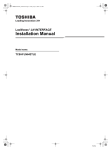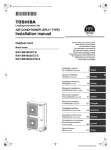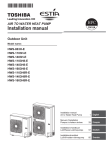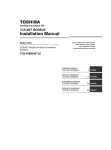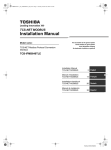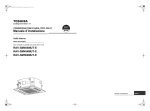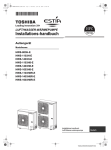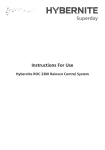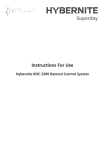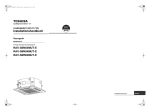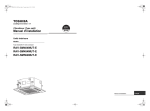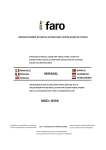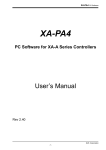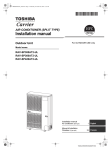Download Installation Manual
Transcript
+00DE93419101-1_00Ta.book Page 1 Wednesday, February 9, 2011 5:27 PM LN INTERFACE Installation Manual Model name: TCB-IFLN642TLE Installation Manual 1 English Manuel d’installation 11 Français Installationshandbuch 21 Deutsch Manuale d’installazione 31 Italiano Toshiba +00DE93419101-1_00Ta.book Page 1 Wednesday, February 9, 2011 5:27 PM Installation Manual LN INTERFACE • Thank you very much for purchasing this TOSHIBA LN interface. • Please read this manual carefully beforehand for proper installation of the LN interface. Contents 1 Precautions for Safety. . . . . . . . . . . . . . . . . . . . . . . . . . . . . . . . . . . . . . . . . . . . . . . . . . 2 2 Introduction . . . . . . . . . . . . . . . . . . . . . . . . . . . . . . . . . . . . . . . . . . . . . . . . . . . . . . . . . . 3 3 Before Installation . . . . . . . . . . . . . . . . . . . . . . . . . . . . . . . . . . . . . . . . . . . . . . . . . . . . . 4 4 Installation . . . . . . . . . . . . . . . . . . . . . . . . . . . . . . . . . . . . . . . . . . . . . . . . . . . . . . . . . . . 4 5 Connection of Power Cables/Communication Cables/Earth Wires . . . . . . . . . . . . . 5 6 Setting. . . . . . . . . . . . . . . . . . . . . . . . . . . . . . . . . . . . . . . . . . . . . . . . . . . . . . . . . . . . . . . 7 7 Trial Operation . . . . . . . . . . . . . . . . . . . . . . . . . . . . . . . . . . . . . . . . . . . . . . . . . . . . . . . . 9 * “ countries. 1-EN “ and “LON” are registered trademarks of Echelon Corporation in United States and other –1– Toshiba XXXXXXX(<SanSerif1>X/X) +00DE93419101-1_00Ta.book Page 2 Wednesday, February 9, 2011 5:27 PM Installation Manual LN INTERFACE 1 Precautions for Safety • Read these “Precautions for Safety” carefully before installation. • The precautions described below include important items regarding safety. Observe them without fail. Understand the following details (indications and symbols) before reading the body text, and follow the instructions. • After the installation work has been completed, perform a trial operation to check for any problems. Explain how to use and maintain the unit to the customer. • Ask customer to keep this Manual at accessible place for future reference. Indication Meaning of Indication WARNING Text set off in this manner indicates that failure to adhere to the directions in the warning could result in serious bodily harm (*1) or loss of life if the product is handled improperly. CAUTION Text set off in this manner indicates that failure to adhere to the directions in the caution could result in serious bodily injury (*2) or damage (*3) to property if the product is handled improperly. *1: Serious bodily harm indicates loss of eyesight, injury, burns, electric shock, bone fracture, poisoning, and other injuries which leave aftereffect and require hospitalization or long-term treatment as an outpatient. *2: Bodily injury indicates injury, burns, electric shock, and other injuries which do not require hospitalization or longterm treatment as an outpatient. *3: Damage to property indicates damage extending to buildings, household effects, domestic livestock, and pets. Symbols EN Meaning of Symbols “ " Indicates prohibited items. The actual contents of the prohibition are indicated by a picture or text placed inside or next to the graphic symbol. “ " Indicates compulsory (mandatory) items. The actual contents of the obligation indicated by a picture or text placed inside or next to the graphic symbol. WARNING • Ask an authorized dealer or qualified installation professional to install or reinstall this unit. Inappropriate installation may result in electric shock or fire. • Electrical work must be performed by a qualified electrician in accordance with this installation manual. The work must satisfy all local, national and international regulations. Inappropriate work may result in electric shock or fire. • Be sure to turn off all main power supply switches before starting any electrical work. Failure to do so may result in electric shock. • Do not modify the unit. A fire or an electric shock may occur. CAUTION • Do not install this unit where flammable gas may leak. If gas leaks and accumulates around the unit, it may cause a fire. • Perform wiring correctly in accordance with specified the current capacity. Failure to do so may result in short-circuiting, overheating or fire. • Use predefined cable and connect them certainly. Keep the connecting terminal free from external force. It may cause an exothermic or a fire. –2– 2-EN Toshiba +00DE93419101-1_00Ta.book Page 3 Wednesday, February 9, 2011 5:27 PM Installation Manual LN INTERFACE 2 Introduction Applicable air conditioners TCC-LINK compatible air conditioners Applications/Functions/Features Applications The LN interface is used to control TCC-LINK compatible Toshiba air conditioners by the building control system using LON (Local Operating Network). Functions The LN interface converts signals between TCC-LINK signals for air conditioners and LONWORKS® signals. Features The LN interface enables various settings such as air conditioner operation stop, temperature, operation mode switching by the building control system, as well as monitoring of operating status, room temperature, various settings, etc. One LN interface has a capacity to control indoor units of up to 64 units. A free topology FT-X1 transceiver is used as the LONWORKS® transceiver (also communicatable with FTT-10A). Specifications Name LN interface Model TCB-IFLN642TLE Power supply 220 - 240 VAC, 50/60 Hz Power consumption 5W Number of connectable indoor units 64 units Operating temperature/humidity 0 to 40 °C, 10 to 90% RH Storage temperature -20 to +60 °C (no condensation) Dimensions 66 (H)×246 (W)×193 (D) mm Mass 1.35 kg External View 246 234 6-Ø5.5 mounting holes 246 219 193 193.4 77 193 77 66 63.6 3-EN –3– Toshiba +00DE93419101-1_00Ta.book Page 4 Wednesday, February 9, 2011 5:27 PM Installation Manual LN INTERFACE 3 Before Installation Check the following package contents. No. Item Quantity 1 LN interface 1 2 Installation Manual 1 3 Screw 4 4 Clamp filter 1 5 Tie-wrap 1 Remarks M4 x 12mm tapping screws For fixing the clamp filter Use the following wiring materials to connect the signal lines and power lines. (Locally procured) No. 1 2 3 4 Line For TCC-LINK For LONWORKS® For power Description Type 2-core shield wires Wire size Length 1.25 mm2, 1000m max. 2.00 mm2, 2000m max. Type Twisted pair shield cable (dedicated cable or equivalent) (total length including air conditioner area) Wire size 0.65 mm × 1P Length Free topology : 500 m max. (total length) Bus topology : 1000 m max. Type Wire size EN H07 RN-F or 245IEC66 0.75mm2, 50 m max. Installation Installation Method and Orientation There are five installation methods as shown in the figure: surface mount and wall mount. Do not install the unit in any other orientation. Use the attached screws. Good No good REQUIREMENT Do not install the unit in any of the following places. • Humid or wet place • Dusty place • Place exposed to direct sunlight or at a high temperature • Place where there is a TV set or radio within one meter • Place exposed to rain (outdoors, under eaves, etc.) Installation Space and Maintenance Space A side space for connecting through cable inlets and an upper space for maintenance must be reserved before installation. The other sides can be adjacent to surrounding objects. 100mm 100mm –4– 4-EN Toshiba +01EN02BODY.fm Page 5 Friday, February 25, 2011 6:29 PM Installation Manual LN INTERFACE 5 Connection of Power Cables/ Communication Cables/Earth Wires Connect power cables, communication cables, and earth wires to the specified terminals on the terminal block. Length of stripped power cable Length of stripped communication cable 50 35 10 10 L N 55 10 Attach the provided Clamp filter to the communication cable. • Attach the Clamp filters to the LONWORKS communication cable as shown right. Fix them to the communication cables with cable ties. • Attach the Clamp filters as close as possible to the LN interface unit. The TCC-LINK communication cable must be earthed on the air conditioner. Do not connect the shield wire to the terminal block. It should be open and insulated. Connect the shield wire of the LONWORKS communication cable to the earth on the upper system side. Do not connect the shield wire to the terminal block. It should be open and insulated. LONWORKS® system U1 LON FG U2 Air conditioner TCC-LINK LED6 LED5 LED4 LED3 LED2 LED1 LED8 LED7 SW5 SW1 SW2 SW3 1 2 3 4 SW8 SW6 SW4 N Power supply 220 - 240 VAC L Connect the earth wire to the earth terminal of the chassis. Connect the power supply cable and earth wire to the terminals using ring terminals with insulation sleeve. REQUIREMENT • Disconnect the appliance from the main power supply. This appliance must be connected to the main power supply by a circuit breaker or switch with a contact separation of at least 3mm. • The TCC-LINK communication cable and the LONWORKS® communication cable have no polarity. • Fasten the screws to the terminal with torque of 0.5Nm. 5-EN –5– Toshiba +00DE93419101-1_00Ta.book Page 6 Wednesday, February 9, 2011 5:27 PM Installation Manual LN INTERFACE The following describes a connection example on the system. Terminator resistor setting TCC-LINK terminator resistor The TCC-LINK terminator resistor is set on the air conditioner side. (See “6 Setting” for setting.) LON terminator resistor The LON terminator resistor is set on the upper LONWORKS® system side. Shield grounding of communication cables TCC-LINK communication cable Do not connect the shield wire to the terminal block. It should be open and insulated. The TCC-LINK communication cable must be earthed on the air conditioner. LONWORKS® communication cable Do not connect the shield wire to the terminal block. It should be open and insulated. Connect the shield wire of the LONWORKS communication cable to the earth on the upper system side. The TCC-LINK terminator resistor is set on the air conditioner side. Set SW5 to OFF. Do not connect the shield wire to the terminal block Building management system (by other company) EN Set (maximum -1) of the indoor unit central control address with SW1 and SW2 in hexadecimal number. Do not connect the shield wire to the terminal block U4 U3 SW5 SW1 LON TCC-LINK TCC-LINK main bus FG U2 U1 LONWORKS (Other company’s system) Outdoor unit U2 U1 U2 U1 Indoor unit The LON terminator resistor is set on the upper LONWORKS® system side. Do not set it here. U4 U3 U4 U3 Central remote controller U2 U1 U2 U1 Indoor unit U2 U1 Indoor unit Remote controller L Remote controller N Power supply 220 - 240 VAC SW2 Outdoor unit LN interface –6– 6-EN Toshiba +00DE93419101-1_00Ta.book Page 7 Wednesday, February 9, 2011 5:27 PM Installation Manual LN INTERFACE 6 Setting The following settings are necessary to use the LN interface. TCC-LINK • SW1/SW2 Set the number of indoor units to be connected. Set the maximum of the indoor unit central control address according to the table below. The factory setting is “3F” (64 units connected). REQUIREMENT The set data is read only when the power is turned on. When changing the SW1/SW2 setting, push the reset switch SW6 after setting. (*) Set the indoor unit central control address from 1 to 64 consecutively. This means that the maximum of the central control address equals the number of connected indoor units. However, if an address is omitted, the maximum of the central control address differs from the number of connected indoor units. In this case, set the maximum of the central control address according to the table below. Note: The system works normally when the set value is larger than the maximum. However, it will result in communication loss. Indoor unit central control address and SW1/SW2 setting 7-EN Indoor unit central control address SW1 SW2 Indoor unit central control address SW1 SW2 Indoor unit central control address SW1 SW2 Indoor unit central control address SW1 SW2 1 0 0 17 1 0 33 2 0 49 3 0 2 0 1 18 1 1 34 2 1 50 3 1 3 0 2 19 1 2 35 2 2 51 3 2 4 0 3 20 1 3 36 2 3 52 3 3 5 0 4 21 1 4 37 2 4 53 3 4 6 0 5 22 1 5 38 2 5 54 3 5 7 0 6 23 1 6 39 2 6 55 3 6 8 0 7 24 1 7 40 2 7 56 3 7 9 0 8 25 1 8 41 2 8 57 3 8 10 0 9 26 1 9 42 2 9 58 3 9 11 0 A 27 1 A 43 2 A 59 3 A 12 0 B 28 1 B 44 2 B 60 3 B 13 0 C 29 1 C 45 2 C 61 3 C 14 0 D 30 1 D 46 2 D 62 3 D 15 0 E 31 1 E 47 2 E 63 3 E 16 0 F 32 1 F 48 2 F 64 3 F –7– Toshiba +00DE93419101-1_00Ta.book Page 8 Wednesday, February 9, 2011 5:27 PM Installation Manual LN INTERFACE • SW3 • SW4 • SW5 Test switch (not used for normal operation, all OFF) Test switch (not used for normal operation) Used to set TCC-LINK terminator resistor. The TCC-LINK terminator resistor is set on the air conditioner side, and is not set here. Set SW5 to “Open”. SW5 TCC-LINK terminator resistor select switch ON 100 ohm • SW6 ON Open Reset switch When changing the setting of the number of connected indoor units with SW1 and SW2, push this reset switch after setting to read the set value. LONWORKS® System LONWORKS® peculiar settings called commissioning and binding are necessary. A specific tool is used for the setting. Ask a professional engineer for this process. • SW8 Service pin for LONWORKS® system Used for Commissioning with the upper LONWORKS® system. EN –8– 8-EN Toshiba +00DE93419101-1_00Ta.book Page 9 Wednesday, February 9, 2011 5:27 PM Installation Manual LN INTERFACE 7 Trial Operation REQUIREMENT • Be sure to specify each unique central control address of the indoor unit. • Be sure to push the reset switch, SW6 on the LN interface after changing or adding the central control address of the indoor unit. Check the communication status between LN interface and indoor units. It can be checked even when the LONWORKS® system is not running. By using SW1, SW2, and SW3, check the communication status of each connected indoor unit with LED4 and LED5. Checking TCC-LINK communication status Set bit 2 of SW3 to “ON” during normal operation. Set the central control address of the target indoor unit with SW1 and SW2 according to “Indoor unit central control address and SW1/SW2 setting” Example: When checking communication status of indoor unit of central control address 25: Set bit 2 of SW3 to “ON”, SW1 to “1”, and SW2 to “8”. Indication of TCC-LINK communication status LED4 and LED 5 show communication status of the indoor unit selected by SW1 and SW2. TCC-LINK communication status LED5 LED4 Remarks Normal ON OFF Normal ON ON Communication with the indoor unit was established previously, but is disabled currently. No indoor unit OFF ON Communication with the indoor unit has never been established. Invalid indoor unit OFF OFF More indoor units are connected than the LN interface can control. End of TCC-LINK communication status check Re-set SW1 and SW2 to the number of connected indoor units, and set bit2 of SW3 to “OFF”. REQUIREMENT Be sure to re-set SW1 and SW2 correctly. Wrong setting may result in a malfunction when the unit is reset. 9-EN –9– Toshiba +00DE93419101-1_00Ta.book Page 10 Wednesday, February 9, 2011 5:27 PM Installation Manual LN INTERFACE LED indication during normal operation LED Normal operation LED1 POWER Power indicator LED2 TCC-LINK TCC-LINK communication status indicator Blinks during TCC-LINK communication. LED3 USB – Not used LED4 BUSY TCC-LINK busy indicator Lights temporarily when TCC-LINK is busy (during auto address setting of an air conditioner, etc.). Communication restarts soon. LED5 TEST Test indicator Used in the test mode. UP-LINK LONWORKS® communication status indicator Blinks during LONWORKS® communication. Lights when reset operation is performed. LED6 LED7 RESET Reset indicator LED8 SERVICE LONWORKS® indicator Lights while the power is on. (*) Ask the manufacturer of the upper system for trial operation check of the LONWORKS® system. EN – 10 – 10-EN Toshiba +00DE93419101-1_00Ta.book Page 11 Wednesday, February 9, 2011 5:27 PM Manuel d’installation INTERFACE LN • Un grand merci d’avoir acheter cette interface LN TOSHIBA. • Avant de procéder à l’installation, veuillez lire attentivement ce manuel pour être en mesure d’effectuer un montage convenable de la interface LN. Table des matières 1 Précautions de sécurité . . . . . . . . . . . . . . . . . . . . . . . . . . . . . . . . . . . . . . . . . . . . . . . 12 2 Introduction . . . . . . . . . . . . . . . . . . . . . . . . . . . . . . . . . . . . . . . . . . . . . . . . . . . . . . . . . 13 3 Avant l’installation. . . . . . . . . . . . . . . . . . . . . . . . . . . . . . . . . . . . . . . . . . . . . . . . . . . . 14 4 Installation . . . . . . . . . . . . . . . . . . . . . . . . . . . . . . . . . . . . . . . . . . . . . . . . . . . . . . . . . . 14 5 Connexion des câbles d’alimentation/câbles de communication/fils de terre . . . 15 6 Réglage. . . . . . . . . . . . . . . . . . . . . . . . . . . . . . . . . . . . . . . . . . . . . . . . . . . . . . . . . . . . . 17 7 Essai de fonctionnement . . . . . . . . . . . . . . . . . . . . . . . . . . . . . . . . . . . . . . . . . . . . . . 19 * « » et « LON » sont des marques déposées de Echelon Corporation aux États-Unis et dans d’autres pays. 1-FR – 11 – Toshiba XXXXXXX(<SanSerif1>X/X) +00DE93419101-1_00Ta.book Page 12 Wednesday, February 9, 2011 5:27 PM Manuel d’installation INTERFACE LN 1 Précautions de sécurité • Lisez attentivement la section « Précautions relatives à la sécurité » avant l’installation. • Les précautions décrites ci-dessous incluent d’importants points relatifs à la sécurité. Respectez-les sans faute. Veillez à comprendre les renseignements suivants (indications et symboles) avant de lire le texte et suivez les instructions. • Une fois l’installation terminée, procédez à un essai de fonctionnement pour vous assurer que tout fonctionne normalement. Expliquez au client comment utiliser l’unité et effectuer son entretien. • Demandez au client de ranger ce mode d’emploi dans un endroit afin qu’il soit accessible pour pouvoir vous y référer plus tard. Indication Signification des indications AVERTISSEMENT ATTENTION Le texte placé de cette manière indique que ne pas suivre les directives de l’avertissement pourrait entraîner de graves blessures corporelles (*1) ou la mort si le produit n’est pas manipulé correctement. Le texte placé de cette manière indique que ne pas suivre les directives de la précaution pourrait entraîner de graves blessures corporelles (*2) ou des dommages sur le bien (*3) si le produit n’est pas manipulé correctement. *1: On entend par grave blessure corporelle, une perte de la vue, des blessures, des brûlures, un choc électrique, une fracture, un empoisonnement et d’autres blessures qui laissent des séquelles et requièrent une hospitalisation ou un traitement de longue durée en tant que patient externe. *2: On entend par blessure corporelle, toute blessure, brûlure, choc électrique et d’autres blessures qui nécessitent une hospitalisation ou un traitement de longue durée en tant que patient externe. *3: On entend par dommages sur le bien, tout endommagement s’étendant aux bâtiments, aux effets mobiliers, aux animaux d’élevage et aux animaux domestiques. Symboles FR Signification des symboles « » indique des points interdits. Le contenu réel de l’interdiction est indiqué par une image ou du texte placé à l’intérieur ou à côté du symbole graphique. « » indique des points obligatoires. Le contenu réel de l’obligation est indiqué par une image ou du texte placé à l’intérieur ou à côté du symbole graphique. AVERTISSEMENT • Pour l’installation ou la réinstallation du logiciel, adressez-vous à un professionnel qualifié. Une installation incorrecte vous expose à une secousse électrique ou à un incendie. • L’installation électrique doit être effectuée par un électricien qualifié conformément à ce manuel d’installation. L’installation doit répondre à tous les règlements locaux, nationaux et internationaux. Une installation inappropriée peut entraîner un choc électrique ou un incendie. • Avant de procéder à l’installation électrique, veillez à mettre l’interrupteur général hors tension. La non-observation de cet avertissement peut se solder par une électrocution. • Ne modifiez pas l’appareil. Un incendie ou un choc électrique risque de se produire. ATTENTION • N’installez pas cette unité dans un endroit où des fuites de gaz inflammable sont possibles. En présence de fuites de gaz et d’accumulation autour de l’unité, un incendie est possible. • Effectuez le câblage conformément aux prescriptions. Dans le cas contraire, vous risquez de provoquer un court-circuit, une surchauffe, voire un incendie. • Utilisez un câble prédéfini et raccordez fermement. Evitez toute force externe sur la borne de raccordement. Cela pourrait entraîner un effet exothermique ou un incendie. – 12 – 2-FR Toshiba +00DE93419101-1_00Ta.book Page 13 Wednesday, February 9, 2011 5:27 PM Manuel d’installation INTERFACE LN 2 Introduction Climatiseurs applicables Climatiseurs compatibles TCC-LINK Applications/Fonctions/Caractéristiques Applications L’interface LN permet de commander les climatiseurs Toshiba compatibles TCC-LINK par le système de contrôle des bâtiments à l’aide de LON (Local Operating Network). Fonctions L’interface LN convertit les signaux entre les signaux TCC-LINK des climatiseurs et les signaux LONWORKS®. Caractéristiques L’interface LN permet différents réglages tels que l’arrêt de fonctionnement du climatiseur, la température, le basculement du mode de fonctionnement par le système de contrôle des bâtiments, de même que la surveillance de l’état de fonctionnement, la température de la pièce, divers réglages, etc. Une seule interface LN est capable de commander des unités intérieures (64 unités maximum). Un émetteur-récepteur FT-X1 à topologie libre est utilisé comme émetteur-récepteur LONWORKS® (également communicable avec FTT-10A). Spécifications Nom Interface LN Modèle TCB-IFLN642TLE Alimentation électrique 220 - 240 VCA, 50/60 Hz Consommation d’énergie 5W Nombre d’unités intérieures connectables 64 unités Température/humidité de fonctionnement 0 à 40 °C, 10 à 90 % HR Température de stockage -20 à +60 °C (sans condensation) Dimensions 66 (H) x 246 (l) x 193 (P) mm Masse 1,35 kg Vue extérieure 246 234 Trous de montage 6-Ø5,5 246 219 193 193.4 77 193 77 66 63.6 3-FR – 13 – Toshiba +00DE93419101-1_00Ta.book Page 14 Wednesday, February 9, 2011 5:27 PM Manuel d’installation INTERFACE LN 3 Avant l’installation Vérifiez la fourniture comme suit. N° Point Quantité 1 Interface LN 2 Manuel d’installation 1 3 Vis 4 4 Filtre à fixer 1 5 Attache autobloquante 1 Remarques 1 Vis autotaraudeuses M4 x 12 mm Pour mettre en place le filtre à fixer Utilisez les moyens de câblage suivants pour relier les lignes de signaux et les lignes d’alimentation. (Fourniture locale) N° 1 Ligne Pour TCC-LINK 2 Pour LONW 3 ORKS® Pour l’alimentation 4 Description Type Câbles blindés à 2 conducteurs Section du câble Longueur 1,25 mm2, 1000 m max. 2,00 mm2, 2000 m max. Type Câble blindé à paires torsadées (câble dédié ou équivalent) Section du câble 0,65 mm × 1P Longueur Topologie libre : 500 m max. (longueur totale) Topologie de bus : 1000 m max. Type Section du câble (longueur totale dont la zone de climatisation) H07 RN-F ou 245IEC66 0,75 mm2, 50 m max. FR Installation Méthode d’installation et disposition Cinq méthodes d’installation sont disponibles, comme illustré dans la figure : pose en surface et pose sur un mur. Ne disposez pas l’unité autrement. Utilisez les vis fournies. Oui Non EXIGENCE N’installez pas l’unité dans un des emplacements suivants. • Humide ou moite • Poussiéreux • Exposé à la lumière directe du soleil ou à une température élevée • À moins d’un mètre d’un téléviseur ou d’une radio • Exposé à la pluie (extérieur, en rive de toit, etc.) Espace requis pour l’installation et l’entretien Avant l’installation, vous devez allouer un espace latéral pour le branchement à travers les câbles d’entrée et un espace supérieur pour la maintenance. Les autres côtés peuvent être adjacents aux objets avoisinants. 100mm 100mm – 14 – 4-FR Toshiba +02FR02BODY.fm Page 15 Friday, February 25, 2011 6:31 PM Manuel d’installation INTERFACE LN 5 Connexion des câbles d’alimentation/ câbles de communication/fils de terre Branchez les câbles d’alimentation, les câbles de communication et fils de terre aux bornes indiquées sur le bornier. Longueur du câble d’alimentation dénudé Longueur du câble de communication dénudé 50 35 10 10 L N 55 10 Connectez le filtre à fixer fourni au câble de communication. • Mettez en place les filtres à fixer sur le câble de communication LONWORKS comme indiqué ci-contre. Connectez-les aux câbles de communication à l’aide de serrecâbles. • Connectez les filtres à fixer aussi près que possible de l’unité d’interface LN. Le câble de communication TCC-LINK doit être mis à la terre sur le climatiseur. Ne raccordez pas le blindage au bornier. Il doit être ouvert et isolé. Reliez le blindage du câble de communication LONWORKS à la terre sur le côté système supérieur. Ne raccordez pas le blindage au bornier. Il doit être ouvert et isolé. U1 U2 Système LONWORKS® LON FG TCC-LINK LED6 LED5 LED4 LED3 LED2 LED1 Climatiseur LED8 LED7 SW5 SW1 SW2 SW3 1 2 3 4 SW8 SW6 SW4 N Alimentation électrique 220 - 240 VCA L Branchez le fil de terre à la borne de terre du châssis. Branchez le câble d’alimentation et le fil de terre aux bornes à l’aide des cosses à anneau avec la gaine isolante. EXIGENCE • Débranchez l’unité de l’alimentation principale. Cet appareil doit être branché au secteur par un disjoncteur ou interrupteur présentant une séparation de contact d’au moins 3 mm. • Le câble de communication TCC-LINK et le câble de communication LONWORKS® n’ont pas de polarité. • Fixez les vis à la borne avec un couple de 0,5 Nm. 5-FR – 15 – Toshiba +00DE93419101-1_00Ta.book Page 16 Wednesday, February 9, 2011 5:27 PM Manuel d’installation INTERFACE LN Vous trouverez ci-après un exemple de connexion dans le système. Réglage de la résistance de terminaison Résistance de terminaison TCC-LINK La résistance de terminaison TCC-LINK est placée côté climatiseur. (Consultez « 6 Réglage » pour le réglage.) Résistance de terminaison LON La résistance de terminaison LON est placée côté système LONWORKS® supérieur. Mise à la terre du blindage des câbles de communication Câble de communication TCC-LINK Ne raccordez pas le blindage au bornier. Il doit être ouvert et isolé. Le câble de communication TCC-LINK doit être mis à la terre sur le climatiseur. Câble de communication LONWORKS® Ne raccordez pas le blindage au bornier. Il doit être ouvert et isolé. Reliez le blindage du câble de communication LONWORKS à la terre sur le côté système supérieur. FR La résistance de terminaison TCCLINK est placée côté climatiseur. Réglez SW5 sur OFF. Ne reliez pas le blindage au bornier Système de gestion des bâtiments (par un tiers) Réglez l’adresse (maximum -1) de la commande centralisée de l’unité intérieure à l’aide de SW1 et SW2 en numérotation hexadécimale. Ne reliez pas le blindage au bornier U4 U3 SW5 SW1 LON TCC-LINK Bus principal TCC-LINK FG U2 U1 LONWORKS (Système de tiers) U2 U1 U2 U1 U4 U3 U2 U1 U2 U1 Unité Unité intérieure intérieure La résistance de terminaison LON est placée côté système LONWORKS® supérieur. Ne la placez pas ici. U4 U3 Télécommande centrale U2 U1 Unité intérieure Télécommande L Télécommande N Alimentation électrique 220 - 240 VCA SW2 Unité Unité extérieure extérieure Interface LN – 16 – 6-FR Toshiba +00DE93419101-1_00Ta.book Page 17 Wednesday, February 9, 2011 5:27 PM Manuel d’installation INTERFACE LN 6 Réglage Les réglages suivants sont nécessaires pour utiliser l’interface LN. TCC-LINK • SW1/SW2 Réglez le nombre d’unités intérieures à connecter. Réglez l’adresse maximale de la commande centralisée de l’unité intérieure selon le tableau cidessous. Le paramètre d’usine est « 3F » (64 unités connectées). EXIGENCE Les données réglées ne sont lisibles qu’à la mise sous tension. Lors de la modification du réglage SW1/SW2, appuyez sur le contacteur de réinitialisation SW6 une fois le réglage effectué. (*) Réglez l’adresse de la commande centralisée de l’unité intérieure de 1 à 64 de manière consécutive. Ceci indique que l’adresse maximale de commande centralisée est égale au nombre d’unités intérieures connectées. Si une adresse est cependant omise, l’adresse maximale de la commande centralisée diffère du nombre d’unités intérieures connectées. Dans ce cas précis, réglez l’adresse maximale de la commande centralisée selon le tableau ci-dessous. Remarque : Le système fonctionne normalement quand la valeur réglée est supérieure au maximum. Toutefois, il s’ensuit une perte de communication. Adresse de la commande centralisée de l’unité intérieure et réglage SW1/SW2 7-FR Adresse de la commande centralisée de l’unité intérieure SW1 SW2 Adresse de la commande centralisée de l’unité intérieure SW1 SW2 Adresse de la commande centralisée de l’unité intérieure SW1 SW2 Adresse de la commande centralisée de l’unité intérieure SW1 SW2 1 0 0 17 1 0 33 2 0 49 3 0 2 0 1 18 1 1 34 2 1 50 3 1 3 0 2 19 1 2 35 2 2 51 3 2 4 0 3 20 1 3 36 2 3 52 3 3 5 0 4 21 1 4 37 2 4 53 3 4 6 0 5 22 1 5 38 2 5 54 3 5 7 0 6 23 1 6 39 2 6 55 3 6 8 0 7 24 1 7 40 2 7 56 3 7 9 0 8 25 1 8 41 2 8 57 3 8 10 0 9 26 1 9 42 2 9 58 3 9 11 0 A 27 1 A 43 2 A 59 3 A 12 0 B 28 1 B 44 2 B 60 3 B 13 0 C 29 1 C 45 2 C 61 3 C 14 0 D 30 1 D 46 2 D 62 3 D 15 0 E 31 1 E 47 2 E 63 3 E 16 0 F 32 1 F 48 2 F 64 3 F – 17 – Toshiba +00DE93419101-1_00Ta.book Page 18 Wednesday, February 9, 2011 5:27 PM Manuel d’installation INTERFACE LN • SW3 • SW4 • SW5 Contacteur de test (Non utilisé en temps normal, tous désactivés) Contacteur de test (Non utilisé en temps normal) Permet de régler la résistance de terminaison TCC-LINK. La résistance de terminaison TCC-LINK est placée côté climatiseur, et n’est pas placée ici. Réglez SW5 sur « Ouvert ». Contacteur de sélection SW5 de la résistance de terminaison TCC-LINK ON 100 ohms • SW6 ON Ouvert Contacteur de réinitialisation Lors de la modification du réglage du nombre d’unités intérieures connectées avec SW1 et SW2, appuyez sur le contacteur de réglage pour lire la valeur réglée. Système LONWORKS® Des réglages spécifiques de LONWORKS® appelés mise en service et connexion sont nécessaires. Ce réglage nécessite un outil spécifique. Contactez un ingénieur pour en savoir plus sur cette procédure. • SW8 Code PIN de service pour le système LONWORKS® Utilisé pour la mise en service avec le système LONWORKS® supérieur. FR – 18 – 8-FR Toshiba +00DE93419101-1_00Ta.book Page 19 Wednesday, February 9, 2011 5:27 PM Manuel d’installation INTERFACE LN 7 Essai de fonctionnement EXIGENCE • Veillez à indiquer chaque adresse unique de la commande centralisée de l’unité intérieure. • Assurez-vous d’appuyer sur le contacteur de réinitialisation SW6 de l’interface LN après avoir modifié ou ajouté l’adresse de la commande centralisée de l’unité intérieure. Vérifiez l’état de communication entre l’interface LN et les unités intérieures. Il peut être vérifié même quand le système LONWORKS® ne fonctionne pas. À l’aide de SW1, SW2 et SW3, vérifiez l’état de communication de chaque unité intérieure connectée avec LED4 et LED5. Vérification de l’état de communication TCC-LINK Réglez le bit 2 de SW3 sur « ON » en temps normal. Réglez l’adresse de la commande centralisée de l’unité intérieur cible à l’aide de SW1 et SW2 selon « Adresse de la commande centralisée de l’unité intérieure et réglage SW1/SW2 ». Exemple : Lors de la vérification de l’état de communication de l’unité intérieure de l’adresse de commande centralisée 25 : Réglez le bit 2 de SW3 sur « ON », SW1 sur « 1 », et SW2 sur « 8 ». Indication de l’état de communication TCC-LINK LED4 et LED5 indiquent l’état de communication de l’unité intérieure sélectionnée par SW1 et SW2. État de communication TCC-LINK LED5 LED4 Remarques Normal ON OFF Normal ON ON La communication avec l’unité intérieure a été établie auparavant mais est actuellement désactivée. Aucune unité intérieure OFF ON La communication avec l’unité intérieure n’a jamais été établie. Unité intérieure non valide OFF OFF Le nombre d’unités intérieures connectées dépasse la capacité de contrôle de l’interface LN. Fin de vérification de l’état de communication TCC-LINK Modifiez le réglage de SW1 et SW2 selon le nombre d’unités intérieures connectées, et réglez le bit 2 de SW3 sur « OFF ». EXIGENCE Veillez à modifier le réglage de SW1 et SW2 correctement. Un réglage incorrect peut entraîner un dysfonctionnement une fois l’unité réinitialisée. 9-FR – 19 – Toshiba +00DE93419101-1_00Ta.book Page 20 Wednesday, February 9, 2011 5:27 PM Manuel d’installation INTERFACE LN Indication des LED en temps normal LED Fonctionnement normal LED1 POWER Indicateur d’alimentation S’allume lors de la mise sous tension. LED2 TCC-LINK Indicateur d’état de communication TCC-LINK Clignote lors de la communication TCC-LINK. LED3 USB – Non utilisé LED4 BUSY Indicateur d’occupation TCC-LINK S’allume temporairement quand TCC-LINK est occupé (lors de l’adressage automatique du climatiseur, etc.). La communication redémarre sous peu. LED5 TEST Indicateur de test Utilisé en mode test. LED6 UP-LINK Indicateur d’état de communication LONWORKS® Clignote pendant la communication de LONWORKS®. LED7 RESET Indicateur de réinitialisation S’allume lors de la réinitialisation. LED8 SERVICE Indicateur LONWORKS® (*) Contactez le fabricant du système supérieur concernant l’essai de fonctionnement du système LONWORKS®. FR – 20 – 10-FR Toshiba +00DE93419101-1_00Ta.book Page 21 Wednesday, February 9, 2011 5:27 PM Installationshandbuch LN-SCHNITTSTELLE • Vielen Dank, dass Sie sich für diese LN-Schnittstelle von TOSHIBA entschieden haben. • Bitte lesen Sie dieses Handbuch sorgfältig vorher durch, um die Installation der LN-Schnittstelle richtig auszuführen. Inhalt 1 Vorsichtsmaßnahmen für die Sicherheit. . . . . . . . . . . . . . . . . . . . . . . . . . . . . . . . . . 22 2 Einleitung . . . . . . . . . . . . . . . . . . . . . . . . . . . . . . . . . . . . . . . . . . . . . . . . . . . . . . . . . . . 23 3 Vor der Installation . . . . . . . . . . . . . . . . . . . . . . . . . . . . . . . . . . . . . . . . . . . . . . . . . . . 24 4 Installation . . . . . . . . . . . . . . . . . . . . . . . . . . . . . . . . . . . . . . . . . . . . . . . . . . . . . . . . . . 24 5 Anschluss der Stromkabel/Kommunikationskabel/Erdungskabel . . . . . . . . . . . . . 25 6 Einstellung . . . . . . . . . . . . . . . . . . . . . . . . . . . . . . . . . . . . . . . . . . . . . . . . . . . . . . . . . . 27 7 Probebetrieb. . . . . . . . . . . . . . . . . . . . . . . . . . . . . . . . . . . . . . . . . . . . . . . . . . . . . . . . . 29 * „ “ und „LON“ sind eingetragene Warenzeichen der Echelon Corporation in den Vereinigten Staaten und in anderen Ländern. 1-DE – 21 – Toshiba XXXXXXX(<SanSerif1>X/X) +00DE93419101-1_00Ta.book Page 22 Wednesday, February 9, 2011 5:27 PM Installationshandbuch LN-SCHNITTSTELLE 1 Vorsichtsmaßnahmen für die Sicherheit • Lesen Sie diese „Sicherheitshinweise“ vor dem Einbau gründlich durch. • Die nachfolgend beschriebenen Vorsichtsmaßnahmen enthalten wichtige Punkte in Bezug auf Sicherheit. Beachten Sie diese unbedingt. Machen Sie sich mit den folgenden Hinweisen und Symbolen vertraut, bevor Sie den Anleitungstext lesen, und befolgen Sie die entsprechenden Anweisungen. • Führen Sie nach der Installation einen Testlauf durch, um das System auf Fehler zu prüfen. Erklären Sie dem Kunden, wie das Gerät bedient und gewartet wird. • Bitten Sie den Kunden, dieses Handbuch zum späteren Nachschlagen an einem gut zugänglichen Ort aufzubewahren. Anzeige Anzeigedarstellung WARNUNG In dieser Form hervorgehobene Textpassagen weisen darauf hin, dass eine Nichtbeachtung des betreffenden „Warnung“-Hinweises zu schweren körperlichen Schäden (*1) oder zum Tode führen kann, wenn das Produkt unsachgemäß gehandhabt wird. VORSICHT In dieser Form hervorgehobene Textpassagen weisen darauf hin, dass eine Nichtbeachtung des betreffenden „Vorsicht“-Hinweises zu schweren Verletzungen (*2) oder zu materiellen Schäden (*3) führen kann, wenn das Produkt unsachgemäß gehandhabt wird. *1: Als „schwere körperliche Schäden“ gelten der Verlust des Augenlichts, Verwundungen, Verbrennungen, Stromschläge, Knochenbrüche, Vergiftungen und sonstige Verletzungen, die bleibende Folgen hinterlassen und einen Krankenhausaufenthalt oder eine langfristige ambulante Behandlung erforderlich machen. *2: Als „schwere Verletzungen“ gelten Verwundungen, Verbrennungen, Stromschläge und sonstige Verletzungen, die keinen Krankenhausaufenthalt und keine langfristige ambulante Behandlung erforderlich machen. *3: Als „materielle Schäden“ gelten Schäden an Gebäuden, Hausratsgegenständen, Nutz- und Haustieren. Symbole Bedeutung der Symbole „ “ weist auf unzulässige Gegenstände hin. Der eigentliche Inhalt des Verbots ist in Bild- oder Textform in oder neben dem Grafiksymbol angegeben. DE „ “ weist auf vorgeschriebene (obligatorische) Gegenstände hin. Der eigentliche Inhalt der Vorschrift ist in Bild- oder Textform in oder neben dem Grafiksymbol angegeben. WARNUNG • Lassen Sie die Installation oder Neuinstallation des Geräts von einem autorisierten Händler oder qualifizierten Profi ausführen. Eine unsachgemäße Installation kann Stromschläge oder Brände verursachen. • Die in diesem Installationshandbuch beschriebenen Elektroarbeiten müssen von einem ausgebildeten Elektriker ausgeführt werden. Bei den Arbeiten müssen alle lokalen, nationalen und internationalen Vorschriften eingehalten werden. Unsachgemäße Arbeiten können Stromschläge oder Brände verursachen. • Ehe Sie irgendwelche Arbeiten an der Elektrik ausführen, schalten Sie die Hauptstromzufuhr ab. Beachten Sie dies nicht, kann ein Stromschlag die Folge sein. • Nehmen Sie keine Veränderungen an dem Gerät vor. Dies könnte Feuer oder Stromschläge verursachen. VORSICHT • Installieren Sie dieses Gerät nicht an einem Ort, an dem entzündbares Gas austreten könnte. Wenn sich das austretende Gas in der Nähe des Geräts ansammelt, besteht Entzündungsgefahr. • Führen Sie die Verkabelung korrekt in Übereinstimmung mit der festgelegten Stromkapazität aus. Wenn das nicht geschieht, besteht die Gefahr von Kurzschluss, Überhitzung oder Bränden. • Verwenden Sie nur die vorgeschriebenen Kabel und schließen Sie diese sicher an. Achten Sie darauf, dass auf die Anschlusskontakte keine äußeren Kräfte einwirken. Dies könnte eine exotherme Reaktion oder Feuer auslösen. – 22 – 2-DE Toshiba +00DE93419101-1_00Ta.book Page 23 Wednesday, February 9, 2011 5:27 PM Installationshandbuch LN-SCHNITTSTELLE 2 Einleitung Geeignete Klimageräte Mit dem TCC-LINK kompatible Klimageräte Anwendungen/Funktionen/Besonderheiten Anwendungen Die LN-Schnittstelle wird von der Gebäudesteuerung verwendet, um mit dem TCC-LINK kompatible ToshibaKlimageräte über ein LON (lokales Netzwerk) zu steuern. Funktionen Die LN-Schnittstelle wandelt Signale zwischen TCC-LINK-Signalen für Klimageräte und LONWORKS®-Signalen um. Besonderheiten Die LN-Schnittstelle ermöglicht unterschiedliche Einstellungen wie Betriebsstopp des Klimageräts, Temperatur, Betriebsartenumschaltung durch die Gebäudesteuerung sowie die Überwachung von Betriebsstatus, Raumtemperatur, verschiedener Einstellungen usw. Eine LN-Schnittstelle ist für die Steuerung von bis zu 64 Innengeräten ausgelegt. Ein FT-X1-Transceiver mit freier Topologie wird als LONWORKS®-Transceiver eingesetzt (kann auch mit FTT-10A kommunizieren). Spezifikationen Bezeichnung LN-Schnittstelle Modell TCB-IFLN642TLE Stromversorgung 220-240 VAC, 50/60 Hz Stromaufnahme 5W Anzahl anschließbarer Innengeräte 64 Geräte Betriebstemperatur/Luftfeuchtigkeit 0 bis 40 °C, 10 bis 90 % relative Feuchte Lagertemperatur -20 bis +60 °C (keine Kondensation) Abmessungen 66 (H) × 246 (B) × 193 (T) mm Gewicht 1,35 kg Außenansicht 246 234 Montagelöcher 6-Ø5,5 246 219 193 193.4 77 193 77 66 63.6 3-DE – 23 – Toshiba +00DE93419101-1_00Ta.book Page 24 Wednesday, February 9, 2011 5:27 PM Installationshandbuch LN-SCHNITTSTELLE 3 Vor der Installation Überprüfen Sie den folgenden Lieferumfang. Nr. Artikel Anzahl 1 LN-Schnittstelle 2 Installationshandbuch 1 3 Schraube 4 4 Klemmenfilter 1 5 Kabelbinder 1 Bemerkungen 1 M4 x 12 mm Schneidschrauben Zur Fixierung des Klemmenfilters Verwenden Sie folgendes Verkabelungsmaterial, um die Signal- und Stromleitungen anzuschließen. (vor Ort bereitzustellen) Nr. 1 Leitung Für TCC-LINK Beschreibung Typ 2-adrige abgeschirmte Kabel Drahtgrößenzahl 1,25 mm2, 1000 m max. 2,00 mm2, 2000 m max. Länge 2 3 4 Für LONW ORKS® Für die Stromversorgung (Gesamtlänge einschließlich Klimagerätebereich) Typ Abgeschirmtes, verdrilltes Zweidraht-Kabel (Spezialkabel oder vergleichbares Kabel) Drahtgrößenzahl 0,65 mm × 1P Länge Freie Topologie: 500 m max. (Gesamtlänge) Bustopologie: 1000 m max. Typ Drahtgrößenzahl H07 RN-F oder 245IEC66 0,75 mm2, 50 m max. Installation DE Installations-Methode und Orientierung Fünf Installationsarten sind möglich (siehe Abbildung): Oberflächenmontage und Wandmontage. Installieren Sie das Gerät nicht mit einer anderen Orientierung. Verwenden Sie die beigefügten Schrauben. Richtig Falsch ANFORDERUNG Installieren Sie das Gerät nicht in einer der folgenden Stellen. • Feuchter oder nasser Ort • Staubiger Ort • Ort, der direkter Sonneneinstrahlung ausgesetzt ist oder an dem hohe Temperaturen herrschen • Ort, wo es einen Fernseher oder Radio in einem Meter Abstand gibt • Ort, der Regen ausgesetzt ist (im Freien, unter Dachvorsprüngen usw.) Installationsplatz und Wartungsplatz Achten Sie bei der Montage darauf, dass an einer Seite genügend Platz für den Anschluss durch Kabelanschlussöffnungen und oben ein ausreichender Zugang für die Wartung vorhanden ist. Bei den übrigen Seiten ist kein Abstand zu nebenstehenden Geräten erforderlich. – 24 – 100mm 100mm 4-DE Toshiba +03DE02BODY.fm Page 25 Friday, February 25, 2011 6:32 PM Installationshandbuch LN-SCHNITTSTELLE 5 Anschluss der Stromkabel/ Kommunikationskabel/Erdungskabel Schließen Sie Stromkabel, Kommunikationskabel und Erdungskabel an die angegebenen Klemmen am Klemmenblock an. Länge des abisolierten Stromkabels Länge des abisolierten Kommunikationskabels 50 35 10 10 L N 55 10 Befestigen Sie den mitgelieferten Klemmenfilter am Kommunikationskabel. • Befestigen Sie die Klemmenfilter am LONWORKS-Kommunikationskabel, wie rechts dargestellt. Befestigen Sie die Filter mit Kabelbindern an den Kommunikationskabeln. • Bringen Sie die Klemmenfilter so nah wie möglich an der LN-Schnittstelleneinheit an. U1 LED6 LED5 LED4 LED3 LED2 LED1 LONWORKS®-System LON FG U2 Klimaanlage Schließen Sie das abgeschirmte Kabel des LONWORKSKommunikationskabels an die Erdung am übergeordneten System an. Schließen Sie das abgeschirmte Kabel nicht am Klemmenblock an. Es sollte offen und isoliert sein. TCC-LINK Das TCC-LINKKommunikationskabel muss am Klimagerät geerdet werden. Schließen Sie das abgeschirmte Kabel nicht am Klemmenblock an. Es sollte offen und isoliert sein. LED8 LED7 SW5 SW1 SW2 SW3 1 2 3 4 SW8 SW6 SW4 N Stromversorgung 220 - 240 VAC L Schließen Sie das Erdungskabel an die Erdungsklemme am Gehäuse an. Schließen Sie das Stromversorgungskabel und das Erdungskabel mithilfe von geschlossenen Kabelschuhen mit Isolierungshüllen an die Klemmen an. ANFORDERUNG • Trennen Sie das Gerät von der Netzversorgung. Das Gerät muss über einen Schutzschalter oder eine Sicherung mit einem Mindestkontaktabstand von 3 mm an die Netzversorgung angeschlossen werden. • Das TCC-LINK -Kommunikationskabel und das LONWORKS®-Kommunikationskabel haben keine Polarität. • Ziehen Sie die Schrauben an der Klemme mit einem Drehmoment von 0,5 Nm an. 5-DE – 25 – Toshiba +00DE93419101-1_00Ta.book Page 26 Wednesday, February 9, 2011 5:27 PM Installationshandbuch LN-SCHNITTSTELLE Im Folgenden wird der Anschluss im System beispielhaft beschrieben. Abschlusswiderstand einstellen TCC-LINK-Abschlusswiderstand Der TCC-LINK-Abschlusswiderstand wird am Klimagerät gesetzt. (Informationen zu den Einstellungen finden Sie in „6 Einstellung“.) LON-Abschlusswiderstand Der LON-Abschlusswiderstand wird am übergeordneten LONWORKS®-System gesetzt. Erdung der Kommunikationskabel TCC-LINK-Kommunikationskabel Schließen Sie das abgeschirmte Kabel nicht am Klemmenblock an. Es sollte offen und isoliert sein. Das TCCLINK-Kommunikationskabel muss am Klimagerät geerdet werden. LONWORKS®-Kommunikationskabel Schließen Sie das abgeschirmte Kabel nicht am Klemmenblock an. Es sollte offen und isoliert sein. Schließen Sie das abgeschirmte Kabel des LONWORKS-Kommunikationskabels an die Erdung am übergeordneten System an. Gebäudemanagementsystem (Fremdfirma) Der TCC-LINKAbschlusswiderstand wird am Klimagerät gesetzt. Stellen Sie SW5 auf „OFF“ (aus). Schließen Sie das abgeschirmte Kabel nicht am Klemmenblock an Stellen Sie die Zentralsteuerungsadresse (max. -1) für das Innengerät über SW1 und SW2 als Hexadezimalzahl ein. DE Schließen Sie das abgeschirmte Kabel nicht am Klemmenblock an U4 U3 SW5 SW1 LON TCC-LINK TCC-LINK-Hauptbus FG U2 U1 LONWORKS (Fremdsystem) U2 U1 U2 U1 Raumgerät Der LON-Abschlusswiderstand wird am übergeordneten LONWORKS®-System gesetzt. Setzen Sie ihn nicht hier. U4 U3 U2 U1 U2 U1 Raumgerät U4 U3 Zentrale Fernbedienung U2 U1 Raumgerät Fernbe-dienung L Fernbe-dienung N Stromversorgung 220 - 240 VAC SW2 Außengerät Außengerät LN-Schnittstelle – 26 – 6-DE Toshiba +00DE93419101-1_00Ta.book Page 27 Wednesday, February 9, 2011 5:27 PM Installationshandbuch LN-SCHNITTSTELLE 6 Einstellung Die folgenden Einstellungen sind für die Verwendung der LN-Schnittstelle erforderlich. TCC-LINK • SW1/SW2 Stellen Sie ein, wie viele Innengeräte angeschlossen werden. Stellen Sie die höchste Innengerät-Zentralsteuerungsadresse gemäß der untenstehenden Tabelle ein. Die Werkseinstellung ist „3F“ (64 Geräte angeschlossen). ANFORDERUNG Die eingestellten Werte werden erst beim Einschalten abgelesen. Wenn Sie die Einstellung für SW1/SW2 ändern, betätigen Sie anschließend den Reset-Schalter SW6. (*) Stellen Sie die Innengerät-Zentralsteuerungsadressen 1 bis 64 nacheinander ein. Dies bedeutet, dass die höchste Zentralsteuerungsadresse der Anzahl der angeschlossenen Innengeräte entspricht. Wird jedoch eine Adresse ausgelassen, so weicht die höchste Zentralsteuerungsadresse von der Anzahl der angeschlossenen Innengeräte ab. Stellen Sie in diesem Fall die höchstmögliche Zentralsteuerungsadresse wie in der Tabelle unten angegeben ein. Hinweis: Das System arbeitet normal, wenn der Einstellwert größer als das Maximum ist. Es kommt jedoch zu Kommunikationsstörungen. Innengerät-Zentralsteuerungsadresse und SW1/SW2 einstellen 7-DE InnengerätZentralsteuerun gsadresse SW1 SW2 InnengerätZentralsteuerun gsadresse SW1 SW2 InnengerätZentralsteuerun gsadresse SW1 SW2 InnengerätZentralsteuerun gsadresse SW1 SW2 1 0 0 17 1 0 33 2 0 49 3 0 2 0 1 18 1 1 34 2 1 50 3 1 3 0 2 19 1 2 35 2 2 51 3 2 4 0 3 20 1 3 36 2 3 52 3 3 5 0 4 21 1 4 37 2 4 53 3 4 6 0 5 22 1 5 38 2 5 54 3 5 7 0 6 23 1 6 39 2 6 55 3 6 8 0 7 24 1 7 40 2 7 56 3 7 9 0 8 25 1 8 41 2 8 57 3 8 10 0 9 26 1 9 42 2 9 58 3 9 11 0 A 27 1 A 43 2 A 59 3 A 12 0 B 28 1 B 44 2 B 60 3 B 13 0 C 29 1 C 45 2 C 61 3 C 14 0 D 30 1 D 46 2 D 62 3 D 15 0 E 31 1 E 47 2 E 63 3 E 16 0 F 32 1 F 48 2 F 64 3 F – 27 – Toshiba +00DE93419101-1_00Ta.book Page 28 Wednesday, February 9, 2011 5:27 PM Installationshandbuch LN-SCHNITTSTELLE • SW3 • SW4 • SW5 Testschalter (keine Verwendung im Normalbetrieb, alle „OFF“ (aus)) Testschalter (keine Verwendung im Normalbetrieb) Wird zum Einstellen des TCC-LINK-Abschlusswiderstands verwendet. Der TCC-LINK-Abschlusswiderstand wird am Klimagerät gesetzt und nicht hier. Legen Sie für SW5 die Einstellung „Offen“ fest. SW5 Wahlschalter für TCCLINK-Abschlusswiderstand ON 100 Ohm • SW6 ON Offen Reset-Schalter Wenn Sie über SW1 und SW2 die eingestellte Anzahl der angeschlossenen Innengeräte ändern, betätigen Sie anschließend diesen Reset-Taster, um den Einstellwert abzulesen. LONWORKS®-System Es sind besondere LONWORKS®-Einstellungen, genannt „Commissioning“ (Anlegen) und „Binding“ (Verbinden), erforderlich. Für diese Einstellung wird ein besonderes Tool benötigt. Fragen Sie einen Fachingenieur nach der Vorgehensweise. • SW8 Servicekontakt für LONWORKS®-System Wird für den Vorgang „Commissioning“ beim übergeordneten LONWORKS®-System verwendet. DE – 28 – 8-DE Toshiba +00DE93419101-1_00Ta.book Page 29 Wednesday, February 9, 2011 5:27 PM Installationshandbuch LN-SCHNITTSTELLE 7 Probebetrieb ANFORDERUNG • Stellen Sie sicher, dass jede Zentralsteuerungsadresse des Innengeräts eindeutig gesetzt ist. • Vergessen Sie nicht, nach dem Anlegen oder Hinzufügen der Zentralsteuerungsadresse für das Innengerät den Reset-Schalter SW6 an der LN-Schnittstelle zu betätigen. Prüfen Sie den Status der Kommunikation zwischen der LN-Schnittstelle und den Innengeräten. Die Prüfung kann auch durchgeführt werden, wenn das LONWORKS®-System nicht in Betrieb ist. Prüfen Sie mit den Schaltern SW1, SW2 und SW3 den Kommunikationsstatus von jedem angeschlossenen Innengerät. Der Status wird von LED4 und LED5 angezeigt. TCC-LINK-Kommunikationsstatus prüfen Setzen Sie im Normalbetrieb Bit 2 von SW3 auf „ON“ (ein). Stellen Sie mit den Schaltern SW1 und SW2 die Zentralsteuerungsadresse des Ziel-Innengeräts gemäß der Tabelle „Einstellung der Zentralsteuerungsadresse und SW1/SW2 für Innengeräte“ ein. Beispiel: Zur Prüfung des Kommunikationsstatus des Innengeräts der Zentralsteuerungsadresse 25: Setzen Sie Bit 2 von SW3 auf „ON“, SW1 auf „1“ und SW2 auf „8“. TCC-LINK-Kommunikationsstatus-Anzeige LED4 und LED 5 zeigen den Kommunikationsstatus des mit SW1 und SW2 ausgewählten Innengeräts an. TCC-LINKKommunikationsstatus LED5 LED4 Normal ON OFF Normal ON ON Kein Innengerät OFF ON Kommunikation mit dem Innengerät wurde nicht hergestellt. OFF Es sind mehr Innengeräte angeschlossen als die LN-Schnittstelle steuern kann. Unzulässiges Innengerät OFF Bemerkungen Kommunikation mit dem Innengerät wurde zuvor hergestellt, ist zurzeit jedoch deaktiviert. TCC-LINK-Kommunikationsstatusprüfung abschließen Setzen Sie SW1 und SW2 auf die Anzahl der angeschlossenen Innengeräte zurück und setzen Sie Bit 2 von SW3 auf „OFF“. ANFORDERUNG Achten Sie darauf, SW1 und SW2 auf die korrekten Werte zurückzusetzen. Eine falsche Einstellung kann beim Rücksetzen des Geräts zu einer Funktionsstörung führen. 9-DE – 29 – Toshiba +00DE93419101-1_00Ta.book Page 30 Wednesday, February 9, 2011 5:27 PM Installationshandbuch LN-SCHNITTSTELLE LED-Anzeige während des Normalbetriebs LED Normalbetrieb LED1 POWER Stromversorgungsanzeige LED2 TCC-LINK Statusanzeige für TCC-LINKKommunikation Blinkt bei TCC-LINK-Kommunikation. LED3 USB – Nicht verwendet LED4 BUSY TCC-LINK-Belegt-Anzeige Leuchtet kurzzeitig auf, wenn der TCC-LINK belegt ist (z. B. während der automatischen Adresseinstellung eines Klimageräts). Die Kommunikation wird zügig wieder aufgenommen. LED5 TEST Testanzeige Verwendung im Testbetrieb. UP-LINK LONWORKS®Kommunikationsstatusanzeige Blinkt bei LONWORKS®-Kommunikation. Leuchtet, wenn der Reset-Vorgang ausgeführt wird. LED6 LED7 RESET Reset-Anzeige LED8 SERVICE LONWORKS®-Anzeige Leuchtet bei eingeschalteter Stromversorgung. (*) Bitten Sie den Hersteller des übergeordneten Systems um eine Probebetrieb-Prüfung des LONWORKS®-Systems. DE – 30 – 10-DE Toshiba +00DE93419101-1_00Ta.book Page 31 Wednesday, February 9, 2011 5:27 PM Manuale d’installazione INTERFACCIA LN • Grazie per aver acquistato questa interfaccia TOSHIBA LN. • Prima di procedere con l’installazione le raccomandiamo di leggere a fondo il presente manuale. Indice 1 Precauzioni per la sicurezza. . . . . . . . . . . . . . . . . . . . . . . . . . . . . . . . . . . . . . . . . . . . 32 2 Introduzione . . . . . . . . . . . . . . . . . . . . . . . . . . . . . . . . . . . . . . . . . . . . . . . . . . . . . . . . . 33 3 Prima di procedere con l’installazione . . . . . . . . . . . . . . . . . . . . . . . . . . . . . . . . . . . 34 4 Installazione . . . . . . . . . . . . . . . . . . . . . . . . . . . . . . . . . . . . . . . . . . . . . . . . . . . . . . . . . 34 5 Collegamento di cavi di alimentazione/cavi di comunicazione/cavi di terra . . . . . 35 6 Impostazione . . . . . . . . . . . . . . . . . . . . . . . . . . . . . . . . . . . . . . . . . . . . . . . . . . . . . . . . 37 7 Prova di funzionamento . . . . . . . . . . . . . . . . . . . . . . . . . . . . . . . . . . . . . . . . . . . . . . . 39 * “ 1-IT ” e “LON” sono marchi di fabbrica registrati di Echelon Corporation negli Stati Uniti e in altri Paesi. – 31 – Toshiba XXXXXXX(<SanSerif1>X/X) +00DE93419101-1_00Ta.book Page 32 Wednesday, February 9, 2011 5:27 PM Manuale d’installazione INTERFACCIA LN 1 Precauzioni per la sicurezza • Leggere le “Precauzioni per la sicurezza” con molta attenzione prima dell’installazione. • Le precauzioni indicate di seguito comprendono degli argomenti importanti relativi alla sicurezza. Devono quindi essere osservate con scrupolo. Comprendere il significato dei seguenti dettagli (indicazioni e simboli) prima di leggere il testo del corpo e seguire le istruzioni. • Dopo l’installazione è consigliabile eseguire una prova di funzionamento per accertarsi che l’impianto funzioni correttamente. Spiegare al cliente come utilizzare e sottoporre a manutenzione l’unità. • Richiedere al cliente di conservare il presente manuale per futuro riferimento. Indicazione Significato delle indicazioni AVVERTENZA Il testo riportato in questo modo indica che il mancato rispetto delle direttive riportate nell’avviso potrebbe provocare gravi ferimenti (*1) o la morte se il prodotto non è gestito in modo appropriato. ATTENZIONE Il testo riportato in questo modo indica che il mancato rispetto delle direttive riportate nella segnalazione potrebbe provocare ferimenti (*2) o danni (*3) alle proprietà se il prodotto non è gestito in modo appropriato. *1: Per ferimenti gravi s’intende la perdita della vista, lesioni, scottature, folgorazioni, fratture ossee, avvelenamento e altre lesioni permanenti che richiedono l’ospedalizzazione o il trattamento a lungo termine come paziente esterno. *2: Per ferimenti s’intende lesioni, scottature, folgorazioni e altre lesioni permanenti che non richiedono l’ospedalizzazione o il trattamento a lungo termine come paziente esterno. *3: Danni alle proprietà indica i danni che si estendo agli edifici, ai beni immobili, agli animali da cortile e agli animali domestici. Simboli Significato dei simboli “ ” Indica argomenti proibiti. I contenuti reali dell’impedimento sono indicati da un’immagine o dal testo posto dall’interno o vicino al simbolo grafico. “ ” Indica argomenti obbligatori. I contenuti reali dell’obbligo sono indicati da un’immagine o dal testo posto dall’interno o vicino al simbolo grafico. IT AVVERTENZA • Per installare o reinstallare questa unità si suggerisce di rivolgersi a un rivenditore autorizzato o a un professionista qualificato. Se l’installazione non viene eseguita correttamente si potranno infatti verificare scosse elettriche o un incendio. • Anche i lavori elettrici devono essere eseguiti da un elettricista qualificato in conformità alle indicazioni del manuale d’installazione. I lavori devono essere conformi a tutte le norme locali, nazionali e internazionali. I lavori male eseguiti possono provocare folgorazioni o incendi. • Prima di avviare qualsiasi lavoro elettrico si deve disalimentare completamente l’unità. Il mancato rispetto di questa precauzione potrebbe divenire causa di scossa elettrica. • Non modificare l’unità. Si possono verificare incendi o folgorazioni. ATTENZIONE • Non installare l’unità in ubicazioni in cui possano verificarsi perdite di gas infiammabili. In caso di perdite di gas che si accumulano attorno all’unità, si possono verificare incendi. • I collegamenti elettrici devono essere eseguiti in osservanza della capacità elettrica installata. In caso contrario si potrebbero generare cortocircuiti, surriscaldamenti o persino incendi. • Utilizzare il cavo predefinito e collegarlo in modo corretto. Conservare il contatto di collegamento lontano da forze esterne. Può provocare un’esotermia o un incendio. – 32 – 2-IT Toshiba +00DE93419101-1_00Ta.book Page 33 Wednesday, February 9, 2011 5:27 PM Manuale d’installazione INTERFACCIA LN 2 Introduzione Condizionatori compatibili Condizionatori compatibili TCC-LINK Applicazioni/Funzioni/Caratteristiche Applicazioni L’interfaccia LN consente di controllare i condizionatori Toshiba compatibili TCC-LINK mediante la creazione di un sistema di controllo dell’edificio utilizzando la LON (Local Operating Network, rete operativa locale). Funzioni L’interfaccia LN converte i segnali tra i segnali TCC-LINK per i condizionatori e i segnali LONWORKS®. Caratteristiche L’interfaccia LN consente di utilizzare varie impostazioni, quali l’arresto del condizionatore, la temperatura, la commutazione del modo di funzionamento mediante il sistema di controllo dell’edificio, nonché il monitoraggio dello stato operativo, della temperatura ambiente e varie altre impostazioni. Un’interfaccia LN ha la capacità di controllare le unità interne di un massimo di 64 unità. Un ricetrasmettitore a topologia libera FT-X1 viene utilizzato come ricetrasmettitore LONWORKS® (in grado di comunicare anche con l’FTT-10A). Caratteristiche tecniche Nome Interfaccia LN Modello TCB-IFLN642TLE Alimentazione elettrica 220 - 240 VCA, 50/60 Hz Consumo elettrico 5W Numero di unità interne collegabili 64 unità Temperatura d’uso e umidità Da 0 a 40°C, dal 10 al 90% RH Temperatura di conservazione Da -20 a +60 °C (non condensante) Dimensioni 66 (A) x 246 (L) x 193 (P) mm Peso 1,35 kg Vista esterna 246 234 Punti di fissaggio 6-Ø5,5 246 219 193 193.4 77 193 77 66 63.6 3-IT – 33 – Toshiba +00DE93419101-1_00Ta.book Page 34 Wednesday, February 9, 2011 5:27 PM Manuale d’installazione INTERFACCIA LN 3 Prima di procedere con l’installazione Contenuto della fornitura: N. Articolo Quantità 1 Interfaccia LN 1 2 Manuale d’installazione 1 3 Vite 4 4 Filtro a morsetto 1 5 Fascetta da legatura 1 Note Viti autofilettanti M4 x 12 mm Per bloccare il filtro a morsetto Per collegare le linee di segnale e le linee di alimentazione si devono usare i seguenti tipi di cavo (da approvvigionare sul posto). N. 1 Linea Per TCC-LINK Descrizione Tipo Cavi isolati a due conduttori Dimensioni dei conduttori 1,25 mm2, massimo 1000 m 2,00 mm2, massimo 2000 m Lunghezza 2 3 4 Per LONW ORKS® Per l’alimentazione (lunghezza totale, compresa l’area del condizionatore) Tipo Cavo schermato a doppino intrecciato (cavo dedicato o equivalente) Dimensioni dei conduttori 0,65 mm × 1P Lunghezza Topologia libera: massimo 500 m (lunghezza totale) Topologia bus: massimo 1000 m Tipo Dimensioni dei conduttori H07 RN-F o 245IEC66 0,75 mm2, massimo 50 m Installazione Metodo di installazione e orientamento Questa interfaccia di ritrasmissione può essere installata in cinque modi diversi, come nell’illustrazione: installazione orizzontale e installazione a parete. Si raccomanda pertanto di non installare l’unità con un orientamento diverso. Utilizzare le viti in dotazione. Corretto IT Non corretto REQUISITO L’apparecchio non deve essere installato: • In luoghi umidi • In luoghi polverosi • In luoghi esposti alla luce solare diretta o a temperature elevate • Entro un metro da televisori o apparecchi radio • In luoghi battuti dalla pioggia (all’esterno, sotto le grondaie e così via) Spazio d’installazione e per manutenzione Prima dell’installazione, lasciare uno spazio laterale per il collegamento degli ingressi dei cavi e uno spazio superiore per la manutenzione. Gli altri lati possono essere adiacenti agli oggetti circostanti. 100mm 100mm – 34 – 4-IT Toshiba +04IT02BODY.fm Page 35 Friday, February 25, 2011 6:36 PM Manuale d’installazione INTERFACCIA LN 5 Collegamento di cavi di alimentazione/cavi di comunicazione/cavi di terra Collegare i cavi di alimentazione, i cavi di comunicazione e i cavi di terra in base ai contatti specifici sulla morsettiera. Lunghezza di spellatura del cavo di alimentazione Lunghezza di spellatura del cavo di comunicazione 50 35 10 10 L N 55 10 Collegare il filtro a morsetto in dotazione al cavo di comunicazione. • Montare i filtri a morsetto al cavo di comunicazione LONWORKS come illustrato a destra. Fissarli ai cavi di comunicazione mediante le apposite giunzioni. • Collegare i filtri a morsetto il più vicino possibile all’unità di interfaccia LN. Il cavo di comunicazione TCCLINK deve essere collegato alla terra sul condizionatore. Non collegare alla morsettiera il cavo schermato. Deve essere spelato e isolato. Collegare il cavo schermato del cavo di comunicazione LONWORKS alla terra sul lato sistema superiore. Non collegare alla morsettiera il cavo schermato. Deve essere spelato e isolato. Sistema LONWORKS® U1 LON FG U2 Condizionatore d’aria TCC-LINK LED6 LED5 LED4 LED3 LED2 LED1 LED8 LED7 SW5 SW1 SW2 SW3 1 2 3 4 SW8 SW6 SW4 N Alimentazione elettrica 220 - 240 VCA L Collegare il cavo di messa a terra al contatto di terra del telaio. Collegare ai contatti il cavo di alimentazione e il cavo di messa a terra, servendosi dei contatti ad anello muniti di guaina isolante. REQUISITO • Scollegare ogni apparecchio dalla linea elettrica di rete. Questa unità deve essere collegata alla linea elettrica principale interponendo un interruttore di sicurezza automatico o un normale interruttore con almeno 3 mm di separazione fra i contatti. • Il cavo di comunicazione The TCC-LINK e il cavo di comunicazione LONWORKS® sono senza polarità. • Serrare le viti al contatto con una coppia di 0,5 Nm. 5-IT – 35 – Toshiba +00DE93419101-1_00Ta.book Page 36 Wednesday, February 9, 2011 5:27 PM Manuale d’installazione INTERFACCIA LN Di seguito viene descritto un esempio di collegamento sul sistema. Impostazione della resistenza di terminazione Resistenza di terminazione TCC-LINK La resistenza di terminazione del TCC-LINK va installata sul lato condizionatore. (Per informazioni sull’impostazione, vedere “6 Impostazione”.) Resistenza di terminazione LON La resistenza di terminazione LON è impostata sul lato superiore del sistema LONWORKS®. Messa a terra schermata dei cavi di comunicazione Cavo di comunicazione TCC-LINK Non collegare alla morsettiera il cavo schermato. Deve essere spelato e isolato. Il cavo di comunicazione TCCLINK deve essere collegato alla terra sul condizionatore. Cavo di comunicazione LONWORKS® Non collegare alla morsettiera il cavo schermato. Deve essere spelato e isolato. Collegare il cavo schermato del cavo di comunicazione LONWORKS alla terra sul lato sistema superiore. Creazione del sistema di gestione (di un’altra azienda) La resistenza di terminazione del TCC-LINK va installata sul lato condizionatore. Impostare SW5 su OFF. Non collegare alla morsettiera il cavo schermato Impostare il valore (massimo -1) dell’indirizzo di controllo centrale dell’unità interna con SW1 e SW2 in cifre esadecimali. IT Non collegare alla morsettiera il cavo schermato U4 U3 SW5 SW1 LON TCC-LINK Bus principale TCC-LINK FG U2 U1 LONWORKS (Sistema di un’altra azienda) U2 U1 U2 U1 Unità interna La resistenza di terminazione LON è impostata sul lato superiore del sistema LONWORKS®. Non deve essere installata qui. U4 U3 U2 U1 U2 U1 Unità interna U4 U3 Telecomando centrale U2 U1 Unità interna Telecomando L Telecomando N Alimentazione elettrica 220 - 240 VCA SW2 Unità esterna Unità esterna Interfaccia LN – 36 – 6-IT Toshiba +00DE93419101-1_00Ta.book Page 37 Wednesday, February 9, 2011 5:27 PM Manuale d’installazione INTERFACCIA LN 6 Impostazione Per utilizzare l’interfaccia LN, sono necessarie le seguenti impostazioni. TCC-LINK • SW1/SW2 Impostare il numero di unità interne da collegare. Impostare il valore massimo dell’indirizzo centrale dell’unità interna facendo riferimento alla tabella seguente. L’impostazione di fabbrica è “3F” (64 unità collegate). REQUISITO I dati impostati vengono letti solo all’accensione. Quando si modifica l’impostazione SW1/SW2, premere il pulsante di reset dopo aver impostato SW6. (*) Impostare l’indirizzo di controllo centrale dell’unità interna su un valore da 1 a 64, consecutivamente. Questo significa che il valore massimo dell’indirizzo di controllo centrale equivale al numero di unità interne collegate. Tuttavia, se un indirizzo viene omesso, il valore massimo dell’indirizzo di controllo centrale differisce dal numero di unità interne collegate. In questo caso, impostare il valore massimo dell’indirizzo di controllo centrale facendo riferimento alla tabella seguente. Nota: il sistema funziona normalmente quando il valore impostato è superiore a quello massimo. Tuttavia, questo provoca una perdita di comunicazione. Impostazione dell’indirizzo di controllo centrale dell’unità interna e SW1/SW2 7-IT Indirizzo di controllo centrale dell’unità interna SW2 Indirizzo di controllo centrale dell’unità interna SW2 Indirizzo di controllo centrale dell’unità interna SW2 Indirizzo di controllo centrale dell’unità interna SW1 SW1 SW1 SW1 SW2 1 2 0 0 17 0 1 18 1 0 33 1 1 34 2 0 49 3 0 2 1 50 3 3 0 2 19 1 2 1 35 2 2 51 3 4 0 3 20 1 2 3 36 2 3 52 3 5 0 4 21 3 1 4 37 2 4 53 3 6 0 5 4 22 1 5 38 2 5 54 3 7 0 5 6 23 1 6 39 2 6 55 3 8 6 0 7 24 1 7 40 2 7 56 3 7 9 0 8 25 1 8 41 2 8 57 3 8 10 0 9 26 1 9 42 2 9 58 3 9 11 0 A 27 1 A 43 2 A 59 3 A 12 0 B 28 1 B 44 2 B 60 3 B 13 0 C 29 1 C 45 2 C 61 3 C 14 0 D 30 1 D 46 2 D 62 3 D 15 0 E 31 1 E 47 2 E 63 3 E 16 0 F 32 1 F 48 2 F 64 3 F – 37 – Toshiba +00DE93419101-1_00Ta.book Page 38 Wednesday, February 9, 2011 5:27 PM Manuale d’installazione INTERFACCIA LN • SW3 • SW4 • SW5 • SW6 Interruttore di prova (non utilizzato per il normale funzionamento, tutto OFF) Interruttore di prova (non utilizzato per il normale funzionamento) Utilizzarlo per impostare la resistenza di terminazione TCC-LINK. La resistenza di terminazione del TCC-LINK va installata sul lato condizionatore, non qui. Impostare SW5 su “Aperta”. Interruttore di selezione della resistenza di terminazione TCC-LINK SW5 ON 100 ohm ON Aperto Pulsante di reset Quando si modifica l’impostazione del numero di unità interne collegate con SW1 e SW2, premere questo pulsante di reset dopo aver impostato la lettura del valore impostato. Sistema LONWORKS® Il sistema LONWORKS® richiede delle particolari impostazioni relative alla messa in funzione e al “binding”. Per l’impostazione viene utilizzato uno strumento specifico. Per informazioni su questo processo, rivolgersi a un tecnico professionista. • SW8 Perno di servizio per il sistema LONWORKS® Utilizzato per la messa in funzione con il sistema superiore LONWORKS®. IT – 38 – 8-IT Toshiba +00DE93419101-1_00Ta.book Page 39 Wednesday, February 9, 2011 5:27 PM Manuale d’installazione INTERFACCIA LN 7 Prova di funzionamento REQUISITO • Assicurarsi di specificare ciascun indirizzo di controllo centrale dell’unità interna. • Assicurarsi di premere il pulsante di reset, SW6 sull’interfaccia LN, dopo aver modificato o aggiunto l’indirizzo di controllo centrale dell’unità interna. Controllare lo stato di comunicazione tra l’interfaccia LN e le unità interne. Esso può essere controllato anche quando il sistema LONWORKS® non è in esecuzione. Utilizzando SW1, SW2 e SW3, controllare lo stato di comunicazione di ciascuna unità interna collegato con LED4 e LED5. Controllo dello stato della comunicazione TCC-LINK Impostare il bit 2 di SW3 su “ON” durante il normale funzionamento. Impostare l’indirizzo di controllo centrale dell’unità interna di destinazione con SW1 e SW2, in base all’indirizzo di controllo centrale dell’unità “interna e all’impostazione SW1/SW2”. Esempio: Quando si controlla lo stato di comunicazione dell’indirizzo di controllo centrale dell’unità interna 25: Impostare il bit 2 di SW3 su “ON”, SW1 su “1” e SW2 su “8”. Indicazione dello stato della comunicazione TCC-LINK LED4 e LED 5 mostrano lo stato di comunicazione dell’unità interna selezionata da SW1 e SW2. Cavo di comunicazione TCC-LINK LED5 LED4 Note Normale ON OFF Normale ON ON La comunicazione con l’unità interna era stata stabilita in precedenza, ma è attualmente disattivata. Nessuna unità interna OFF ON La comunicazione con l’unità interna non è mai stata stabilita. Unità interna non valida OFF OFF Sono collegate più unità interne di quante ne possa controllare l’interfaccia LN. Fine dello stato della comunicazione TCC-LINK Reimpostare SW1 e SW2 sul numero di unità interne collegate e impostare bit2 di SW3 su “OFF”. REQUISITO Assicurarsi di reimpostare correttamente SW1 e SW2. Delle impostazioni errate potrebbero provocare un problema di funzionamento al momento del ripristino dell’unità. 9-IT – 39 – Toshiba +00DE93419101-1_00Ta.book Page 40 Wednesday, February 9, 2011 5:27 PM Manuale d’installazione INTERFACCIA LN Indicazione LED durante il normale funzionamento LED Funzionamento normale LED1 POWER Indicatore di alimentazione Si accende quando l’alimentazione è attivata. LED2 TCC-LINK Indicatore dello stato della comunicazione TCC-LINK Lampeggia durante la comunicazione TCC-LINK. LED3 USB – Non utilizzato LED4 BUSY Indicatore di occupato TCC-LINK Si accende temporaneamente quando TCC-LINK è occupato (durante l’impostazione di indirizzo automatico di un condizionatore, ecc.). La comunicazione si riavvia presto. LED5 TEST Indicatore di prova Utilizzato in modalità di funzionamento di prova. UP-LINK Indicatore di stato della comunicazione Lampeggia durante la comunicazione LONWORKS®. LONWORKS® LED7 RESET Indicatore di reset LED8 SERVICE Indicatore LONWORKS® LED6 Appare quando viene eseguita l’operazione di ripristino. (*) Chiedere al produttore del sistema superiore di effettuare il controllo dell’operazione di prova del sistema LONWORKS®. IT – 40 – 10-IT Toshiba +00DE93419101-1_00Ta.book Page 41 Wednesday, February 9, 2011 5:27 PM Manuale d’installazione INTERFACCIA LN MEMO ................................................................................................... ................................................................................................... ................................................................................................... ................................................................................................... ................................................................................................... ................................................................................................... ................................................................................................... ................................................................................................... ................................................................................................... ................................................................................................... ................................................................................................... ................................................................................................... ................................................................................................... ................................................................................................... ................................................................................................... ................................................................................................... ................................................................................................... ................................................................................................... ................................................................................................... ................................................................................................... ................................................................................................... ................................................................................................... ................................................................................................... ................................................................................................... ................................................................................................... ................................................................................................... ................................................................................................... ................................................................................................... ................................................................................................... ................................................................................................... ................................................................................................... – 41 – Toshiba +00DE93419101-1_00Ta.book Page 42 Wednesday, February 9, 2011 5:27 PM Manuale d’installazione INTERFACCIA LN MEMO ................................................................................................... ................................................................................................... ................................................................................................... ................................................................................................... ................................................................................................... ................................................................................................... ................................................................................................... ................................................................................................... ................................................................................................... ................................................................................................... ................................................................................................... ................................................................................................... ................................................................................................... ................................................................................................... ................................................................................................... ................................................................................................... ................................................................................................... ................................................................................................... ................................................................................................... ................................................................................................... ................................................................................................... ................................................................................................... ................................................................................................... ................................................................................................... ................................................................................................... ................................................................................................... ................................................................................................... ................................................................................................... ................................................................................................... ................................................................................................... ................................................................................................... – 42 – Toshiba IT +00DE93419101-1_00Ta.book Page 43 Wednesday, February 9, 2011 5:27 PM DE93419101-1 Toshiba












































